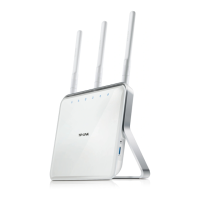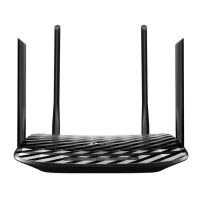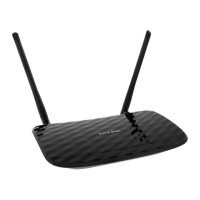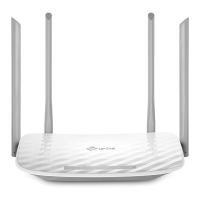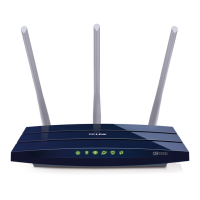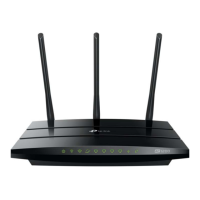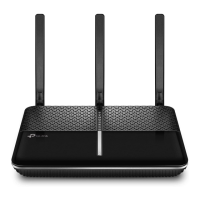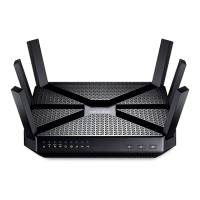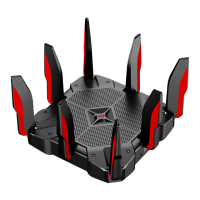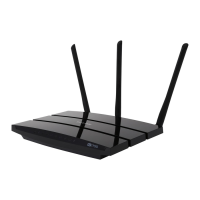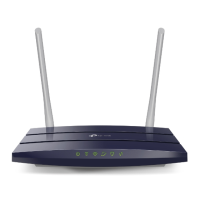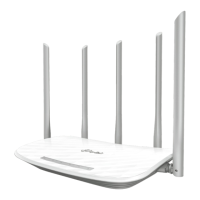Do you have a question about the TP-Link Archer C88 and is the answer not in the manual?
Overview of the TP-Link router's features, performance, and ease of use.
Details the physical appearance and layout of the router.
Describes the top panel of the router, including LED indicators.
Details the back panel of the router, including buttons and ports.
Provides guidelines on where to place the router for optimal performance and safety.
Step-by-step instructions for physically connecting the router to your network.
Walks users through the router's automatic setup process for internet connection.
Explains how to use the TP-Link Tether app for a quick router setup.
Provides manual steps to configure the internet connection based on ISP details.
Instructions to configure the router to extend an existing wired network wirelessly.
Details how to set up an internet connection using the IPv6 protocol.
Step-by-step guide to create a TP-Link ID for cloud management services.
Instructions on how to modify the email address and password associated with a TP-Link ID.
Explains how to add or remove other TP-Link IDs to manage the router.
Guide on using the TP-Link Tether app for remote router management.
Instructions for setting up a unified Wi-Fi network with OneMesh extenders.
How to view and manage devices connected within a OneMesh network.
Steps to create a separate Wi-Fi network for guests, ensuring privacy.
How to configure specific permissions and options for the guest network.
Guide to block inappropriate content and set internet access time limits.
How to prioritize network traffic and allocate bandwidth for better performance.
Steps to enable the firewall for protection against cyber threats.
How to block or allow specific devices from accessing the network.
Binding IP to MAC addresses to prevent ARP spoofing and attacks.
Explains the ALG settings and recommends default configuration.
How to make local network services accessible from the internet via port forwarding.
Configuring port triggering to dynamically open ports for specific applications.
Enabling UPnP to improve performance for online gaming and other applications.
Setting up a DMZ host to bypass port restrictions for applications.
How to modify the router's LAN IP address and subnet mask.
Steps to configure the router for IPTV services, including IGMP settings.
Configuring the DHCP server to assign IP addresses and reserve IPs for devices.
Setting up DDNS to access the router remotely using a domain name.
Manually configuring routing information for data packets to specific destinations.
Customizing wireless network name (SSID), password, and security options.
Setting a schedule for the wireless network to automatically turn on/off.
Instructions for connecting devices to the router using the WPS button.
Configuring advanced wireless parameters like WMM, AP Isolation, etc.
Setting up WDS bridging to extend wireless network coverage with another router.
Instructions for updating the router's firmware to the latest version.
How to back up and restore router configuration settings.
Changing the password used to log into the router's web management page.
Limiting which devices on the LAN can manage the router using MAC address authentication.
Enabling and configuring remote access to manage the router from outside the local network.
Explains the HTTP Referer Head Check feature for CSRF attack protection.
How to save and view system logs for troubleshooting router issues.
Configuring CWMP (TR-069) settings for auto-configuration by the ISP.
Using Ping and Tracert tools to test network connectivity and diagnose issues.
Configuring the router's system time, time zone, and language.
Scheduling automatic reboots for the router to maintain performance.
Managing the router's LED indicators, including enabling Night Mode.
Overview of the TP-Link router's features, performance, and ease of use.
Details the physical appearance and layout of the router.
Describes the top panel of the router, including LED indicators.
Details the back panel of the router, including buttons and ports.
Provides guidelines on where to place the router for optimal performance and safety.
Step-by-step instructions for physically connecting the router to your network.
Walks users through the router's automatic setup process for internet connection.
Explains how to use the TP-Link Tether app for a quick router setup.
Provides manual steps to configure the internet connection based on ISP details.
Instructions to configure the router to extend an existing wired network wirelessly.
Details how to set up an internet connection using the IPv6 protocol.
Step-by-step guide to create a TP-Link ID for cloud management services.
Instructions on how to modify the email address and password associated with a TP-Link ID.
Explains how to add or remove other TP-Link IDs to manage the router.
Guide on using the TP-Link Tether app for remote router management.
Instructions for setting up a unified Wi-Fi network with OneMesh extenders.
How to view and manage devices connected within a OneMesh network.
Steps to create a separate Wi-Fi network for guests, ensuring privacy.
How to configure specific permissions and options for the guest network.
Guide to block inappropriate content and set internet access time limits.
How to prioritize network traffic and allocate bandwidth for better performance.
Steps to enable the firewall for protection against cyber threats.
How to block or allow specific devices from accessing the network.
Binding IP to MAC addresses to prevent ARP spoofing and attacks.
Explains the ALG settings and recommends default configuration.
How to make local network services accessible from the internet via port forwarding.
Configuring port triggering to dynamically open ports for specific applications.
Enabling UPnP to improve performance for online gaming and other applications.
Setting up a DMZ host to bypass port restrictions for applications.
How to modify the router's LAN IP address and subnet mask.
Steps to configure the router for IPTV services, including IGMP settings.
Configuring the DHCP server to assign IP addresses and reserve IPs for devices.
Setting up DDNS to access the router remotely using a domain name.
Manually configuring routing information for data packets to specific destinations.
Customizing wireless network name (SSID), password, and security options.
Setting a schedule for the wireless network to automatically turn on/off.
Instructions for connecting devices to the router using the WPS button.
Configuring advanced wireless parameters like WMM, AP Isolation, etc.
Setting up WDS bridging to extend wireless network coverage with another router.
Instructions for updating the router's firmware to the latest version.
How to back up and restore router configuration settings.
Changing the password used to log into the router's web management page.
Limiting which devices on the LAN can manage the router using MAC address authentication.
Enabling and configuring remote access to manage the router from outside the local network.
Explains the HTTP Referer Head Check feature for CSRF attack protection.
How to save and view system logs for troubleshooting router issues.
Configuring CWMP (TR-069) settings for auto-configuration by the ISP.
Using Ping and Tracert tools to test network connectivity and diagnose issues.
Configuring the router's system time, time zone, and language.
Scheduling automatic reboots for the router to maintain performance.
Managing the router's LED indicators, including enabling Night Mode.
| Wireless Standard | IEEE 802.11ac |
|---|---|
| Frequency Bands | 2.4 GHz, 5 GHz |
| Maximum Wireless Speed | 1900 Mbps |
| USB Ports | 1 x USB 2.0 |
| Ethernet Ports | 4 x 10/100/1000 Mbps LAN, 1 x 10/100/1000 Mbps WAN |
| Ports | 4 x LAN, 1 x WAN |
| Antennas | 3 x External Antennas |
| Processor | Dual-core |
| Memory | 128 MB |
| Security | WPA, WPA2 |
| VPN Support | PPTP, L2TP |
| Dimensions | 9.57 x 6.3 x 1.3 in |
